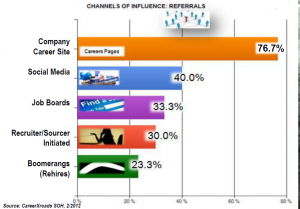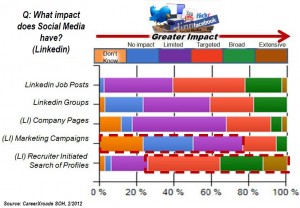Ask the next hire you onboard to describe everything, every step they took on their way to becoming a candidate, and you may be in for a surprise.
If you track your source of hire, chances are excellent that what your numbers tell you is only a part of the story — the most recent part. What all that data is telling you may be not more than from where your new hire submitted their application.
With two-thirds of the companies participating in CareerXroads’ source of hire survey relying on the hires to say how they learned of the job, “What that’s telling us is what the candidate remembers, which is going to be from where they applied. You might get them to tell you where they first heard about the job,” says Gerry Crispin, one of the survey authors. “But we’ve suspected that more goes into this than is being captured (by source of hire reporting).”
Best thinking on what influences new hires to apply
So for the first time in the 11 years CareerXroads has surveyed America’s largest employers on how and from where they make hires, this year’s report includes the best thinking of recruiting leaders about what influenced their new hires to apply.
 The just released report, 2012 CareerXroads Sources of Hire: Channels that Influence, not only offers a look at what recruiting leaders believe about the pathways in talent acquisition, but it also provides a data-rich look at where the 36 responding companies attribute the hires they make. The sources of hire were detailed on TLNT yesterday. Today’s post looks at the social media influencers of that hiring.
The just released report, 2012 CareerXroads Sources of Hire: Channels that Influence, not only offers a look at what recruiting leaders believe about the pathways in talent acquisition, but it also provides a data-rich look at where the 36 responding companies attribute the hires they make. The sources of hire were detailed on TLNT yesterday. Today’s post looks at the social media influencers of that hiring.
It turns out that although social media accounted for a mere 3.5 percent of the 213,375 hires the 36 responding companies made last year, the leaders believe it plays a consistent and influential role in acquiring talent.
“It’s all speculation why they said that,” explains Crispin, “because we have no data.” However, he hastens to add, “They may not know, but they are good guessers.”
Referrals, which accounted for 28 percent of last year’s external hires, has five main channels influencing candidates. The company career site is believed by 76.7 percent of the leaders to be one. Social media, say 40 percent, plays a role, too.
Likewise, when the company career site is listed as the official source of hire, 62.5 percent of the survey respondents believe social media was among the influencers. Only job boards ae believed by more leaders (75 percent) to play a role in influencing candidates.
Social media — more value than just the numbers
 Other channels certainly play a role. Recruiting leaders, sometimes by significant percentages, cited job boards, referrals, and the company site itself at least as often as social media.
Other channels certainly play a role. Recruiting leaders, sometimes by significant percentages, cited job boards, referrals, and the company site itself at least as often as social media.
Thus social media, like the role referrals plays in influencing hiring pathways, offers greater value to a corporate talent strategy than the number of hires would suggest. And that may well be why recruiting leaders mentioned improvements to their social media programs among their planned changes this year.
“Social media has much more value than we can see just from the numbers,” says Crispin. “It may not yet be leading directly to hires, but like referrals, it has a strong influence.”
Some social media tools are better for the job than others. Besides asking leaders their opinion of the multiple channels that influence the various hiring source, Crispin and his partner Mark Mehler asked them to rate the impact of certain sites and techniques.
By far LinkedIn has a greater impact than either of the two other leading social sites, Facebook and Twitter. Despite the presence of two job-focused apps — BranchOut and Monster’s BeKnown — the recruiters said Facebook generally had no or very limited impact on their talent acquisition efforts. Facebook’s company pages were given credit for having at least some limited and targeted impacts by about half the respondents. Otherwise, though, three-quarters or more of the recruiting leaders felt it had no impact.
LinkedIn: It’s a clear choice of leaders
Twitter fared somewhat better, with about half the respondents saying that it had some value as a job posting and communication medium. About 40 percent think it has limited value as a direct sourcing tool.
 LinkedIn, however, was the clear choice of the leaders. Nearly all of them thought posting jobs on LinkedIn had an impact; with almost 40 percent saying it had a targeted impact. It has even greater impact, said some three-quarters of the respondents, when it comes to searching profiles and sourcing candidates; a quarter reported LinkedIn profile searches had a broad or even extensive impact.
LinkedIn, however, was the clear choice of the leaders. Nearly all of them thought posting jobs on LinkedIn had an impact; with almost 40 percent saying it had a targeted impact. It has even greater impact, said some three-quarters of the respondents, when it comes to searching profiles and sourcing candidates; a quarter reported LinkedIn profile searches had a broad or even extensive impact.
The CareerXroads Sources of Hire survey confirms a Bullhorn report, which, among its conclusions, found LinkedIn to be a more effective a candidate source than either Facebook or Twitter.
Bullhorn didn’t report on hires. But on driving views of job postings and applications, it said “LinkedIn is the most productive network overall for driving job views,” and that “LinkedIn drives almost nine times more applications than Facebook and three times more applications than Twitter.”
